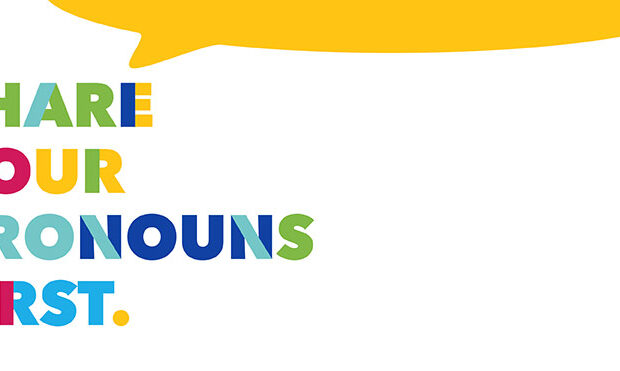Gender equity pronouns have rich history of experimentation

Pronouns are an essential part of everyday language and gender expression. But she/her and he/him can be suffocating to people who don’t fit into the gender binary of male and female. So people have been trying to make gender-neutral pronouns that fit into grammar rules, can be inclusive of everyone and can give gender euphoria to non-binary people.
Director of the Cedar Valley LGBT coalition Melody Kosobucki spokeon the importance of teaching about gender-neutral pronouns. “Honoring a person’s pronouns is really a part of acknowledging that person as a whole. For example, I identify as a female and use she/her pronouns. If someone was to refer to me with he/him pronouns that would really make me uncomfortable because those pronouns aren’t a part of my gender identity. Their pronouns are a part of how they support their identity and how they communicate with those around them. It’s important that we utilize those pronouns to connect to people. Misgendering people can be harmful and offensive because you’re denying their identity.“
Common pronouns are pronouns that were coined before the 18th century/modern era. These words were in use during the middle ages or earlier. Gender-neutral common pronouns include:
Gender-neutral he: Grammerians in the 18th century suggested using a “he” when a gender-neutral pronoun was needed instead of they because they could be used in a plural sense, which could be confusing, but using he can also be confusing because it makes it unclear whether the writing is about men only, and the use of a gender-neutral he in law has been used to discriminate against women because politicians would interpret the “he” as meaning male. In the 1970s feminists Casey Miller and Katie Swift worked to replace the gender-neutral he in law with “he or she.”
Gender-neutral she: Feminist Dana Densmore (from the article “Speech is the Form of Thought ”) has said that the gender-neutral he should be replaced with a gender-neutral he, as it includes “he” within “she.”
Singular they/them/their: Usage of singular they has been used since the 1400s, but during the 18th century it was the hot controversy among grammarians as they argued that it was always plural. It is still the most popular way to refer to someone with unknown pronouns and is the most popular pronoun among non-binary people. Notable authors who have used singular “they” have been Chaucer, Shakespeare, Jane Austin and C.S Lewis. Singular “they” is currently recognized by APA and MLA. More on how singular they functions in grammar is found here. It is the most common gender-neutral pronoun according to the 2021 gender census and 79.2 percent of participants used they/them.
It/its/itself/which: It is the standard pronoun for animals, objects and infants. It is often considered demeaning to use for a person and its history of being used in transphobic ways, but some trans people reclaim it and challenge the idea that being considered genderless is inherently dehumanizing. “Which” can also be used in this set as suggested by poet Samuel Taylor Coleridge in an issue of Anima Poetae in 1808. The 2021 gender census reports that 9.3 percent of participants use it/its.
People can also mix pronouns together. A common example of this would be someone using he/they/she depending on how they feel, but someone can mix any pronouns together.
Neopronouns are pronouns coined in the modern era or the 18th century to the current day. They have been used to solve the issue of people being uncomfortable with “it” pronouns or to make a gender-neutral pronoun that is singular.
E/Em/Eir/Eirs/Emself or Spivak pronouns: These were first used in Micheal Spivak’s manual The Joy of TeX (1986), which was a guide to the software AMSTeX, so no one in the examples the book uses would have a specific gender. It was popularized by the online chat LambdaMOO in 1991. Maia Konabe, the author of the graphic memoir Genderqueer, uses these pronouns in Eir’s book, in the 2021 Gender Census, and 4.3 percent of participants used these pronouns, making it the fifth most used gender-neutral pronoun set.
S/he/SHe/sHe/hir/hirs/hirself: First used in books by American psychologist Timothy Leary in the ’70s, these pronouns inspired other counter-culture writers to put these pronouns in their books such as Prometheus Rising (1983) and Peter David’s Star Trek books. Leslie Feinberg, who wrote Stone Butch Blues, did use these pronouns. “I asked Beacon Press to use s/he [sic] in the author description of me on the cover of Transgender Warriors [another book by Feinberg]. That pronoun is a contribution from the women’s liberation movement. Prior to that struggle, the pronoun ‘he’ was almost universally used to describe humankind—’mankind,’ so s/he’ opened up the pronoun to include ‘womankind.’ I used s/he on my book jacket because it is recognizable as a gender-neutral pronoun to people, but I personally prefer the pronoun ze because, for me, it melds mankind and womankind into humankind.”
Xe/xyr/xem/xyrself/xemself: Xe is based on the pronoun gender-neutral German pronoun “sie” and is pronounced: “zee.” “Xe” was coined by Don Rickter in the May 1, 1973, edition of the Unitarian Universalist World Magazine. Rickter’s pronoun was also referenced in the 1973 journal Kickshaws by David L. Silverman. The pronouns Xe, xyr and xem together earliest recorded history were in an autism mailing list called the ANI-list, which was the mailing list for Autism Network International in 1993, but the way that it is used in this discussion aids that it was used before this conversation. The 2021 gender census reports that 8.5 percent of participants use Xe/xem/xyr/xyrs/xemself, (and there are other variations/sets of xe. This is just the most popular set).
Ze/hir/hirself: Used in Kate Bornstein’s books Nearly Roadkill (1996) and My Gender Workbook (1989) to refer to hirself, other trans people and people of non-specific/unknown gender. “Ze” likely originated before then but these books are the earliest recorded version I could find. The 2021 gender census reports that 4.2 percent of participants use Ze/hir, and there are other pronoun sets including hir or ze that are still used.
Noun pronouns: Noun pronouns are any pronouns that use a noun in place of a pronoun like he or them. The most popular example of this would be “fae/faer” pronouns, which are based off mythological creatures from European folklore. The 2021 gender census reports that 6.5 percent of participants use fae/faer, but someone could use any noun as a pronoun based on what connects to their personality and gender expression. For example, if someone feels like they have a strong interest in goth culture and dressing goth makes them feel more confident, they could then have a pronoun that is goth themed like Bat/bats.
And some people don’t like using pronouns for themselves at all or don’t care about any specific pronoun. The 2021 gender census reported that 12.6 percent of participants only went by their name and that 13.2 percent of participants used any pronoun
Regarding what schools could do to promote gender pronoun education, Kosobucki said, “I think a lot of it comes from creating a culture that is inclusive of everyone. Folks who are in leadership like administration and teachers need to first understand why this is important, then work together to adopt a culture that does not tolerate a person who is disrespectful of someone’s pronouns. If you have an environment where people can be themselves, it’s easier to promote that kindness. The issue of pronouns seems like a smaller piece of a larger puzzle, but it’s a crucial piece of respecting people as a human. A Lot of this work has to be done at the administrative level.”









You must be logged in to post a comment Login